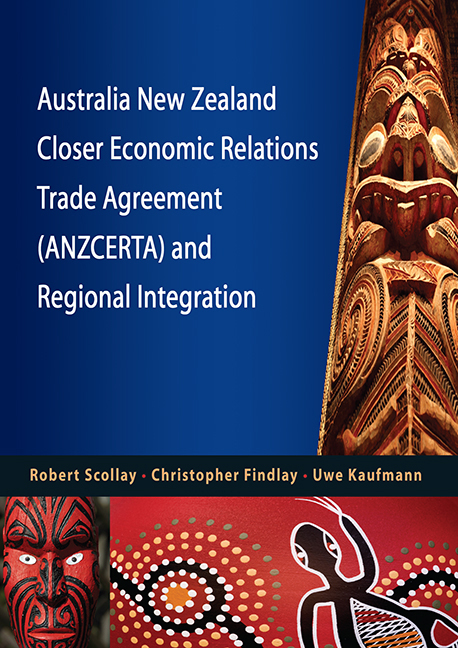Book contents
- Frontmatter
- Contents
- Foreword
- Australia New Zealand Closer Economic Relations Trade Agreement (Anzcerta) and Regional Integration
- Executive Summary
- 1 Introduction
- 2 Background
- 3 Pre-ANZCERTA Trade Arrangements
- 4 Early Years of ANZCERTA
- 5 Consolidation of ANZCERTA
- 6 Deepening Integration
- 7 Pursuit of a Single Economic Market (SEM)
- 8 Further Monetary Integration: A Monetary Union?
- 9 The Economic Effects of ANZCERTA
- 10 Conclusion
- References
- About the Authors
7 - Pursuit of a Single Economic Market (SEM)
from Australia New Zealand Closer Economic Relations Trade Agreement (Anzcerta) and Regional Integration
Published online by Cambridge University Press: 21 October 2015
- Frontmatter
- Contents
- Foreword
- Australia New Zealand Closer Economic Relations Trade Agreement (Anzcerta) and Regional Integration
- Executive Summary
- 1 Introduction
- 2 Background
- 3 Pre-ANZCERTA Trade Arrangements
- 4 Early Years of ANZCERTA
- 5 Consolidation of ANZCERTA
- 6 Deepening Integration
- 7 Pursuit of a Single Economic Market (SEM)
- 8 Further Monetary Integration: A Monetary Union?
- 9 The Economic Effects of ANZCERTA
- 10 Conclusion
- References
- About the Authors
Summary
For many years ANZCERTA was the only preferential trade agreement in which either country was involved, excluding the non-reciprocal South Pacific Regional Trade and Economic Cooperation Agreement (SPARTECA) with the independent Pacific island states, and Australia's Papua New Guinea-Australia Trade and Commercial Relations Agreement (PATCRA) with Papua New Guinea. From 2000 onward however, first New Zealand, and then Australia, became active participants in the rapid spread of preferential trade agreements in the Asia-Pacific region. Pursuit of economic integration with other partners in the Asia-Pacific region was being accorded an increased priority by both countries. These developments raised questions over the degree of priority that both countries would in future place on their bilateral relationship, especially as they chose to pursue their new preferential arrangements individually rather than jointly.
Rather than allow the bilateral economic relationship to wither, however, the two countries decided instead to try to rejuvenate it. An important step in this direction was the creation by the two governments of the Trans-Tasman Leadership Forum, comprised of business leaders and other experts and leading figures from both countries. The forum meets annually and is charged with identifying and prioritizing avenues for deepening the economic relationship. At the governmental level the decision to rejuvenate the relationship was encapsulated in the commitment by the two countries in 2004 to pursue the achievement of a Single Economic Market (SEM). This commitment has been followed by significant developments in a number of areas.
Rules of Origin
In 2006 the two countries agreed on a major change in the ANZCERTA rules of origin, involving a switch to Change in Tariff Classification (CTC) as the principal basis for determining origin, with exporters retaining the option of using the old RVC- based rules for a further five years. For some products, mainly in the textile and apparel area, a “dual” requirement was imposed whereby the RVC rule and a CTC rule had to be satisfied simultaneously, while for a very small number of products in one apparel sub-heading, the RVC rule was retained as the sole rule of origin. These provisions were intended to allay concerns of industries in both countries that had expresses serious reservations over the change to CTC rules. The change was implemented in 2007.
- Type
- Chapter
- Information
- Australia New Zealand Closer Economic Relations Trade Agreement (ANZCERTA) and Regional Integration , pp. 57 - 68Publisher: ISEAS–Yusof Ishak InstitutePrint publication year: 2010



